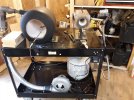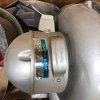DanF
Knifemaker / Craftsman / Service Provider
- Joined
- Apr 17, 2017
- Messages
- 1,437
I had not used this forge since building it as everything I forged ( up to 13” knives), would fit in my Atlas Mini. Now, I need to put the built one to regular use. Is there any way to reconfigure the pipes to cut down on that weight and bulk asis, and would this forge be considerably safer, or just a little safer with the blower above everything Vs the current location?
Thanks

Thanks



